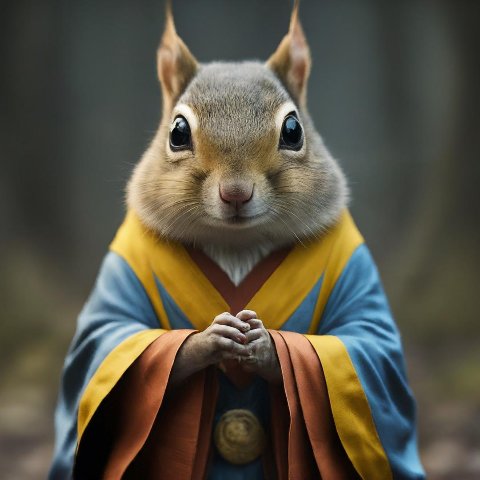Squirrels, Taiji and Stillness
By: Cheng Tong - Feb 27, 2024
Squirrels, Taiji and Stillness
All of my students have met my squirrel. We became friends a couple of years ago, and we share a few moments together each day. I’ve written about her before, including even a poem.
She comes each day to eat peanuts with me on one of the benches in the meditation garden that surrounds my training and teaching deck. Sometimes she will sit in my lap, sometimes she will sit on the cushion beside me, and sometimes she just sits on the cinder block armrest. But she comes every day, and several times at that.
It is necessary that I leave a small pile of peanuts for her during every class. If she comes and does not find them waiting for her, she will walk up onto the deck and come to me, interrupting class while she pleads for them with a beseeching look, front paws clutched.
When I am on the deck for my own daily training, she will sit and watch me play taiji. I have joked with my students that certainly she has watched enough to have learned every form I play, five in number, and probably goes home to play on her own. I created the image above using AI tools, and am now thinking of using AI tools to produce a “deep fake” video of her playing taiji.
The thing is, though, that the squirrel does not need taiji to cultivate stillness. She is exactly what she is – a squirrel – at all times. She puts on no airs, does not pretend to be anything other than a squirrel, and already lives moment to moment. For her, the moment is all there is, and her life (other than evading predators) is simple – eating when she is hungry, sleeping when she is tired.
If only it were true for all of us, too.
Among the courses I teach at Blue Heron Stillness is Daoist Arts. I use three ancient scrolls I brought back from my temple in
How could adornment be a barrier to spiritual growth, you ask? It depends on the attention and weight attached to one’s appearance and presentation, the clothing worn, the accessories chosen, and the reasons for both.
“People in the world take adornment heavily while taking inner content lightly. They recognize the false and discard truth. People worry others will make fun of them and therefore adorn themselves in beautiful clothing. People make themselves beautiful in order to laugh at others; they pretend to have high morals in order to lie to others. When people put much time into only this, how can they cultivate stillness and walk a path of spiritual growth with this perspective? It is by fulfilling one’s duty, not seeking fame and wealth, maintaining simplicity, being dependable, giving respect to the Way, considering virtue as valuable, that all affairs are completed and progress moves everywhere.”
From The 49 Barriers To Spiritual Growth – Adornment
Now, consider the squirrel. Her coat is like all others, her tail, too. She does not seek attention, and certainly does not consider herself to be beautiful, or lie to other squirrels. She is simply a squirrel, always.
Now, my squirrel is not going to help me with the NYT Spelling Bee each morning, of course. Nor will she study Daoist Arts with me. She is, after all, a squirrel. That doesn’t mean we can’t learn something from her, though.
She doesn’t need to cultivate stillness, nor does she need to meditate, play taiji, or adorn herself with lovely clothes and accessories. Yet, she is always in the moment, and that is where we all wish to be, always, too.
That is what she teaches us. Be in each moment fully, and be who we are, with neither adornment nor pretense. Just be. In that way, you are able to live a fully engaged life, just like my squirrel.

